Dutch council for refugees
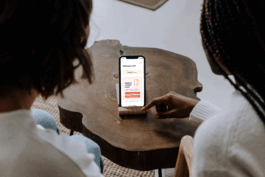
Supporting autonomy and administrative literacy by developing an AI-tool for refugee-background individuals to help with official communication management
Data-driven Design, Product Design, UX & UI Design, UX Research, Data Science, Information Design
client: Dutch Council for Refugees
year: 2024-25
Refugee-background individuals in the Netherlands face ongoing challenges in navigating official communication, particularly during the early years of resettlement. In collaboration with VluchtelingenWerk Nederland (VWN) , a national NGO that supports refugees throughout their whole journey after arriving in the Netherlands, this project responds to the need for better support around bureaucratic correspondence.
Many of VWN’s clients, who have received a temporary residence permit, receive a high volume of complex letters from various institutions, including the municipality, tax office, and healthcare providers. These letters are often difficult to understand, and it is not always clear what actions are required: “Now clients often rely on social workers to help them navigate through this maze, but we would like to empower our clients to be as independent as possible.” This challenge is supported by existing research, which shows that unclear procedures, complex language, and fragmented information systems can lead to missed deadlines, stress, and long-term reliance on support workers.
Approach
Before diving into the design process itself, the project started by developing an understanding for the problem space and the user group. This inlcuded interviews, observations as well as desk research. While there has been a rise in refugee-focused apps, many of them concentrate on translation or isolated tasks, often overlooking deeper needs like independence and understanding how the system works.
The development of an solution for this challenge followed the Double Diamond process – a design method used to move from complex problems to clear, tested solutions, aiming for a context-sensitive, value-driven approach: The design research moved from early insights to iterative prototyping and usability testing, aiming for a context-sensitive, value-driven approach. The synthesis of the research done in the exploration phase (interviews, observations, etc.) provided a clearer definition of the design challenge: The issue extends beyond limited Dutch proficiency. It involves how information is structured, the unfamiliarity of institutional systems, and the emotional strain of constant dependence. These reflect a broader lack of context, confidence, and systemic understanding. At its core, the challenge is a lack of administrative literacy – defined as the ability to interact with public administrations. The synthesis also led to the identification of key design values, which guided all following stages of ideation, development, and evaluation: independence, trust, accessibility, clarity, knowledge, support and safety/trust.
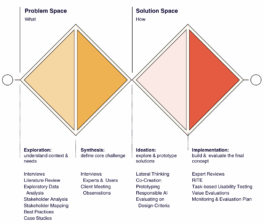
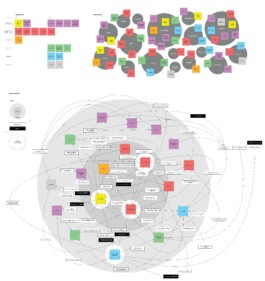
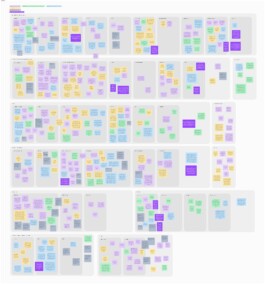
Ideation
To explore potential solutions, the project entered the ideation phase using lateral thinking techniques, including provocations, values mapping, and structured feature evaluation. Over 200 ideas were generated – not to find a single definitive concept, but to explore a wide range of possibilities, from unconventional to practical. Allowing ideas to emerge without premature evaluation made it possible to think beyond obvious solutions and explore the full complexity of the problem space. These ideas were then organised, refined, and evaluated through a structured design process following the Double Diamond model as well, moving from broad exploration to focused prototyping and ethical evaluation.
Involving refugees and social workers with co-creation activities provided critical insights into which features aligned with users’ actual lived experiences and real needs. The resulting ideas were clustered and filtered through prioritisation methods as well as constant evaluation on the design criteria, which helped focus on ideas that were both feasible and aligned with the values. These methods also helped guard against common design risks such as privilege hazard, where solutions reflect the designer’s perspective more than the user’s, and techno-solutionism, the assumption that social problems can be fixed through technology alone. This reflective approach continued through prototyping and the integration of responsible AI principles, ensuring the tool supported autonomy, transparency, and ethical use. It also aims to foster data literacy by helping users understand how their information is processed, interpreted, and used to generate guidance.
This process resulted into four core ideas, that got combined into one cohesive system.
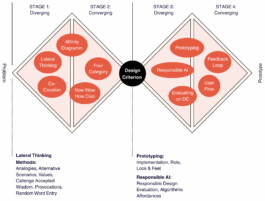
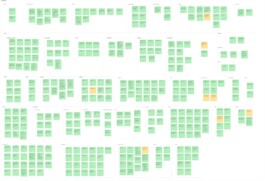
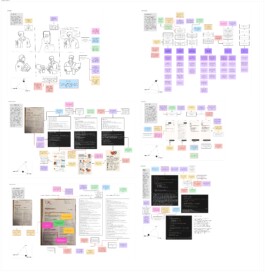
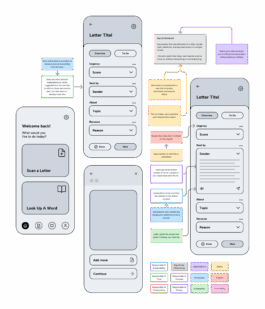
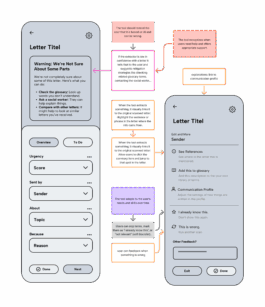
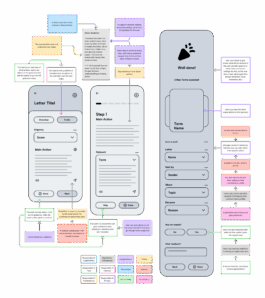

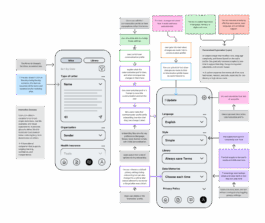
Usability Testing
To assess whether the designed tool was effective, understandable, and aligned with it’s intended values, a structured evaluation process was conducted involving 36 participants. These included refugee-background individuals, non-European migrants with similar experiences, NGO professionals, design experts, and members of the public. Participants were asked to use the tool to complete tasks with a real letter example while thinking aloud, followed by structured reflections and short surveys. The evaluation focused not only on usability, but also on whether the tool supported the design values.
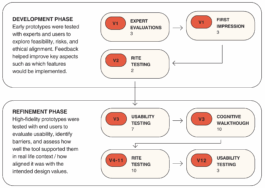
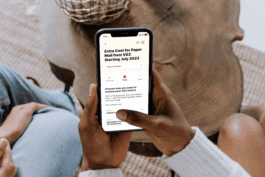

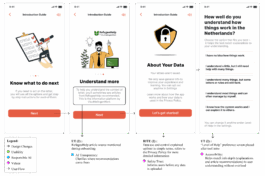
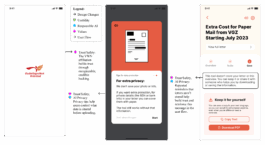
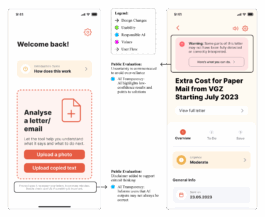
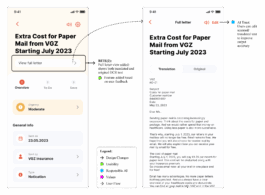
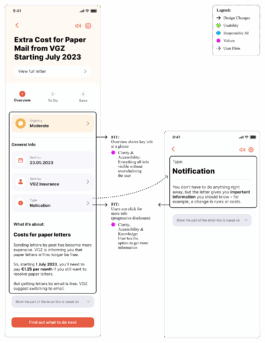


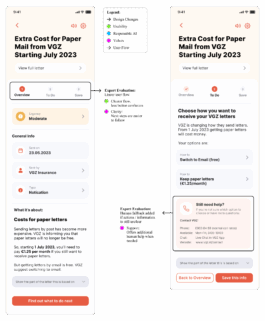

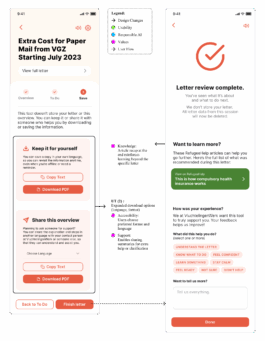
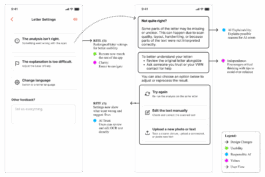
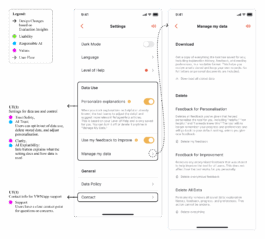
Data Science
The development of the tool’s functionality and data science components occurred in parallel with these design iterations and influenced each other. The data flow diagram below shows how a letter is processed from input and analysis to enriched, actionable output: key elements include OCR, NLP-based information extraction, explanation generation, and contextual article recommendations.
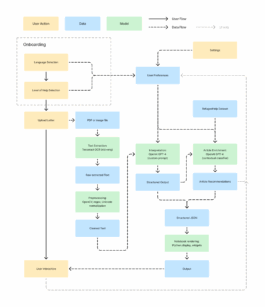
Result
The iterated final prototype integrates natural language processing (NLP), value-sensitive design, and responsible AI principles to support refugee-background individuals in navigating official communication.
It does so through five core features:
- Extract key information (e.g. urgency, sender, type, subject) from letters
- Simplify bureaucratic language using personalised, literacy-level–adjusted explanations.
- Provide step-by-step action guidance to help users act on the communication.
- Recommend relevant articles from VluchtelingenWerk’s information platform, RefugeeHelp.nl, based on the letter’s content and user needs.
- Promote safety and autonomy through transparency and user control over data.



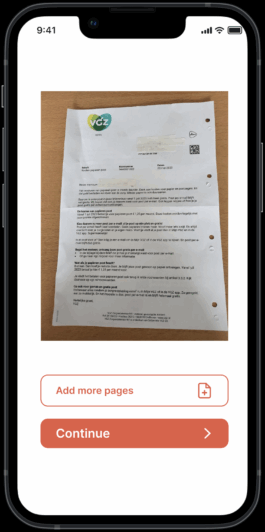


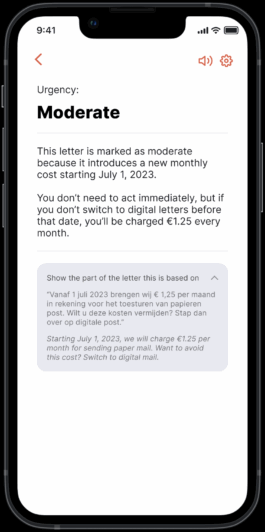

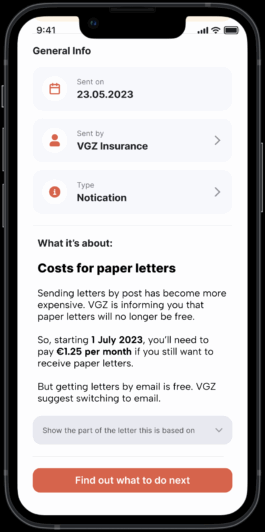



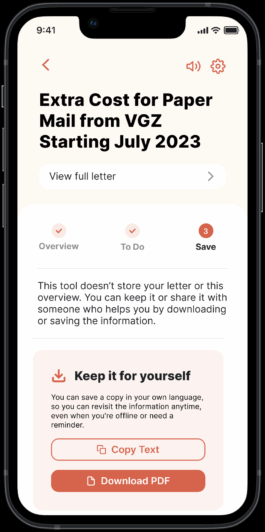

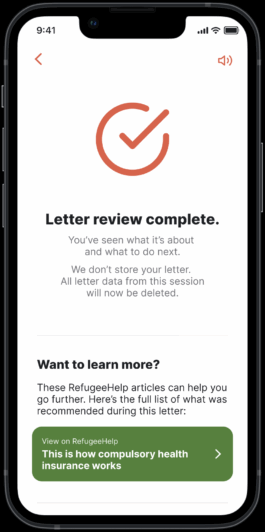
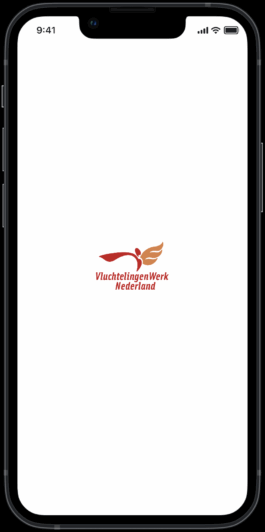
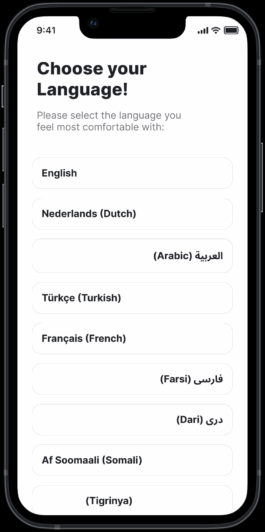
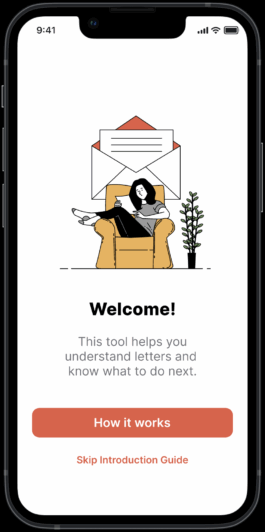
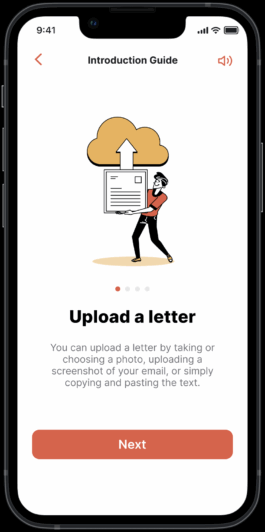
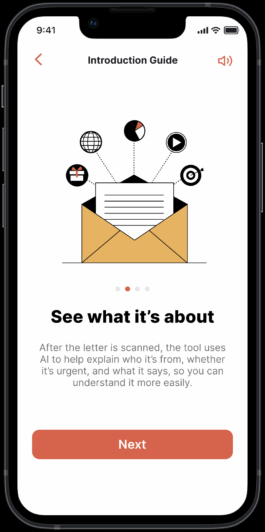

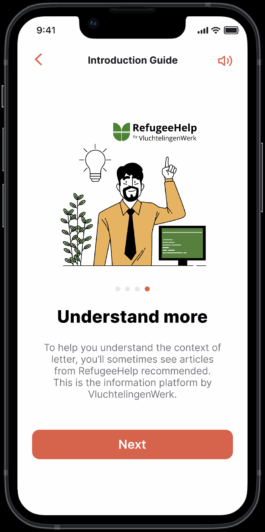
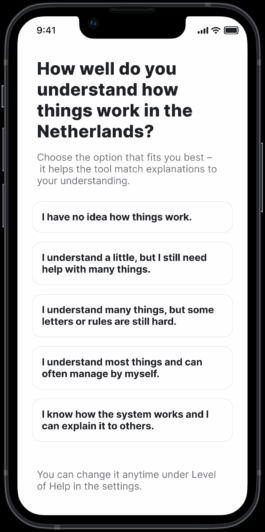


Dutch Council for refugees
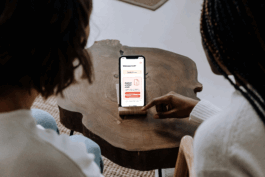
Supporting autonomy and administrative literacy by developing an AI-tool for refugee-background individuals to help with official communication management
Data-driven Design, Product Design, UX & UI Design, UX Research, Data Science, Information Design
client: Dutch Council for Refugees
year: 2024-25
Refugee-background individuals in the Netherlands face ongoing challenges in navigating official communication, particularly during the early years of resettlement. In collaboration with VluchtelingenWerk Nederland (VWN) , a national NGO that supports refugees throughout their whole journey after arriving in the Netherlands, this project responds to the need for better support around bureaucratic correspondence.
Many of VWN’s clients, who have received a temporary residence permit, receive a high volume of complex letters from various institutions, including the municipality, tax office, and healthcare providers. These letters are often difficult to understand, and it is not always clear what actions are required: “Now clients often rely on social workers to help them navigate through this maze, but we would like to empower our clients to be as independent as possible.” This challenge is supported by existing research, which shows that unclear procedures, complex language, and fragmented information systems can lead to missed deadlines, stress, and long-term reliance on support workers.
Approach
Before diving into the design process itself, the project started by developing an understanding for the problem space and the user group. This inlcuded interviews, observations as well as desk research. While there has been a rise in refugee-focused apps, many of them concentrate on translation or isolated tasks, often overlooking deeper needs like independence and understanding how the system works.
The development of an solution for this challenge followed the Double Diamond process – a design method used to move from complex problems to clear, tested solutions, aiming for a context-sensitive, value-driven approach: The design research moved from early insights to iterative prototyping and usability testing, aiming for a context-sensitive, value-driven approach. The synthesis of the research done in the exploration phase (interviews, observations, etc.) provided a clearer definition of the design challenge: The issue extends beyond limited Dutch proficiency. It involves how information is structured, the unfamiliarity of institutional systems, and the emotional strain of constant dependence. These reflect a broader lack of context, confidence, and systemic understanding. At its core, the challenge is a lack of administrative literacy – defined as the ability to interact with public administrations. The synthesis also led to the identification of key design values, which guided all following stages of ideation, development, and evaluation: independence, trust, accessibility, clarity, knowledge, support and safety/trust.



Ideation
To explore potential solutions, the project entered the ideation phase using lateral thinking techniques, including provocations, values mapping, and structured feature evaluation. Over 200 ideas were generated – not to find a single definitive concept, but to explore a wide range of possibilities, from unconventional to practical. Allowing ideas to emerge without premature evaluation made it possible to think beyond obvious solutions and explore the full complexity of the problem space. These ideas were then organised, refined, and evaluated through a structured design process following the Double Diamond model as well, moving from broad exploration to focused prototyping and ethical evaluation.
Involving refugees and social workers with co-creation activities provided critical insights into which features aligned with users’ actual lived experiences and real needs. The resulting ideas were clustered and filtered through prioritisation methods as well as constant evaluation on the design criteria, which helped focus on ideas that were both feasible and aligned with the values. These methods also helped guard against common design risks such as privilege hazard, where solutions reflect the designer’s perspective more than the user’s, and techno-solutionism, the assumption that social problems can be fixed through technology alone. This reflective approach continued through prototyping and the integration of responsible AI principles, ensuring the tool supported autonomy, transparency, and ethical use. It also aims to foster data literacy by helping users understand how their information is processed, interpreted, and used to generate guidance.
This process resulted into four core ideas, that got combined into one cohesive system.








Usability Testing
To assess whether the designed tool was effective, understandable, and aligned with it’s intended values, a structured evaluation process was conducted involving 36 participants. These included refugee-background individuals, non-European migrants with similar experiences, NGO professionals, design experts, and members of the public. Participants were asked to use the tool to complete tasks with a real letter example while thinking aloud, followed by structured reflections and short surveys. The evaluation focused not only on usability, but also on whether the tool supported the design values.















Data Science
The development of the tool’s functionality and data science components occurred in parallel with these design iterations and influenced each other. The data flow diagram below shows how a letter is processed from input and analysis to enriched, actionable output: key elements include OCR, NLP-based information extraction, explanation generation, and contextual article recommendations.
The iterated final prototype integrates natural language processing (NLP), value-sensitive design, and responsible AI principles to support refugee-background individuals in navigating official communication.

Result
It does so through five core features:
- Extract key information (e.g. urgency, sender, type, subject) from letters
- Simplify bureaucratic language using personalised, literacy-level–adjusted explanations.
- Provide step-by-step action guidance to help users act on the communication.
- Recommend relevant articles from VluchtelingenWerk’s information platform, RefugeeHelp.nl, based on the letter’s content and user needs.
- Promote safety and autonomy through transparency and user control over data.
























